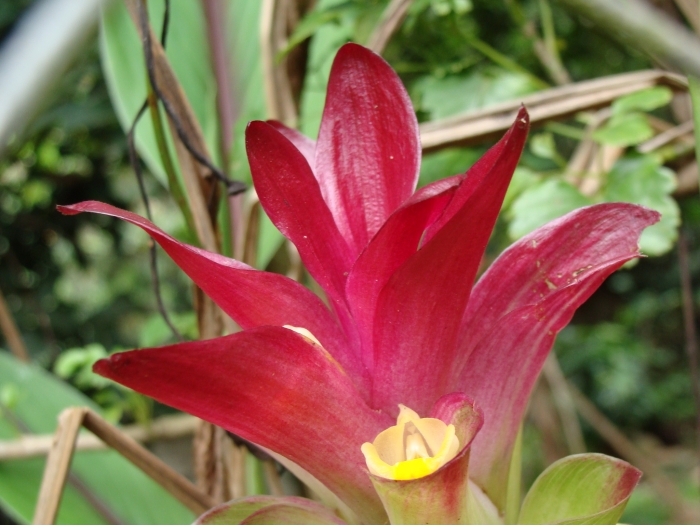Turmeric
(Curcuma longa)
Turmeric (Curcuma longa)
/
/

© Alexis López Hernández
CC BY 4.0
Image By:
© Alexis López Hernández
Recorded By:
Copyright:
CC BY 4.0
Copyright Notice:
Photo by: © Alexis López Hernández | License Type: CC BY 4.0 | License URL: http://creativecommons.org/licenses/by/4.0/ | Uploader: alexiz | Publisher: iNaturalist |






















Estimated Native Range
Summary
Curcuma longa, commonly known as turmeric, is a perennial herbaceous plant native to tropical South Asia, particularly the Indian subcontinent, where it thrives in the warm and humid conditions of monsoon forests and secondary forests. It typically grows to a height of up to 3 feet tall, with a spread of about 1 foot. Turmeric has highly branched, yellow to orange, cylindrical, aromatic rhizomes. The leaves are large, alternate, and lanceolate with a length of up to 45 centimeters and a width of up to 18 centimeters. The inflorescence is a central spike up to 12 centimeters long. The flowers are pale yellow, appearing in the center of the leafy bracts.
Turmeric is valued for its rhizomes, which are harvested for culinary use as a spice and for dyeing, imparting a distinctive yellow color. It is a key ingredient in many Asian dishes, contributing to the flavor and color of curries and other recipes. In addition to its culinary uses, turmeric is used in traditional medicine, although there is no high-quality evidence supporting its medicinal efficacy. For cultivation, turmeric prefers warm temperatures between 20-30°C and requires high annual rainfall or supplemental irrigation. It grows best in fertile, well-drained soil with good organic content. In non-tropical climates, turmeric can be grown in containers and brought indoors during cooler months. It is generally free from serious pests and diseases but can be susceptible to fungal diseases if overwatered or grown in poorly drained soils.CC BY-SA 4.0
Turmeric is valued for its rhizomes, which are harvested for culinary use as a spice and for dyeing, imparting a distinctive yellow color. It is a key ingredient in many Asian dishes, contributing to the flavor and color of curries and other recipes. In addition to its culinary uses, turmeric is used in traditional medicine, although there is no high-quality evidence supporting its medicinal efficacy. For cultivation, turmeric prefers warm temperatures between 20-30°C and requires high annual rainfall or supplemental irrigation. It grows best in fertile, well-drained soil with good organic content. In non-tropical climates, turmeric can be grown in containers and brought indoors during cooler months. It is generally free from serious pests and diseases but can be susceptible to fungal diseases if overwatered or grown in poorly drained soils.CC BY-SA 4.0
Plant Description
- Plant Type: Bulb
- Height: 3-4 feet
- Width: 3-4 feet
- Growth Rate: Moderate
- Flower Color: Cream, White, Yellow
- Flowering Season: Spring, Summer
- Leaf Retention: Deciduous
Growth Requirements
- Sun: Part Shade
- Water: Medium
- Drainage: Medium
Common Uses
Edible*Disclaimer: Easyscape's listed plant edibility is for informational use. Always verify the safety and proper identification of any plant before consumption., Low Maintenance, Potted Plant
Natural Habitat
Tropical South Asia, particularly the Indian subcontinent
Other Names
Common Names: Indian-Saffron , Haldi , Açafroeira , Açafrão-Da-Terra , Common Turmeric , Gengibre-Dourada , Ukon , Ulgeum
Scientific Names: Curcuma longa , Amomum curcuma , Amomum curcuma , Curcuma brog , Curcuma domestica , Curcuma domestica , Curcuma longa var. vanaharidra , Curcuma ochrorhiza , Curcuma soloensis , Curcuma tinctoria
GBIF Accepted Name: